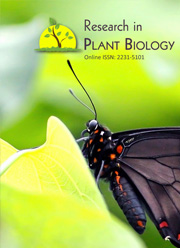Development of fungi on Lupinus angustifolius L. and Lupinus luteus L.
Keywords:
lupine (Lupinus L.), fungi, micromycetes, anthracnoseAbstract
Testing for fungal, micromycetes and anthracnose in lupine varieties was conducted at the Voke Branch of Lithuanian Institute of Agriculture during a competitivetrial of feeding lupine (Lupinus L.) in 2005 - 2007. Application of lupines for green manure in fruit and vegetables gardens enriches the soil with nitrogen and other nutrients, influences species composition and functional properties of microorganisms developingin plant rhizosphere. In rhizosphere and on the above ground parts of lupines cultivated for green manure certain micromycete species, potential infection agents of plants grownin fruit and vegetable gardens, are recorded. Here belong some species of the FusariumLink, Pythium Nees, Thielaviopsis Went, Rhizoctonia DC., Phoma Sacc., Ascochyta Lib.,Romuliaria Sacc., Septoria Sacc., Erysiphe R. Hedw.ex DC. genera. Particularly hazardousto plants are fungi of the Colletotrichum (Corda) genus, which frequently infect lupines.The main routs of distribution of potentially hazardous fungi are seeds and phytopathogenic condition of soil in which plants grow. The phytopathogenic condition depends upon a few factors: resistance of lupines grown for green manure to various disease agents, proper treatment of seeds before sowing, selection of preplant and soil preparation that suppress the development of phytopathogens and stimulating plant growth powers.Downloads
Download data is not yet available.
Published
15-04-2011
How to Cite
Nedzinskiene, T. L., & Asakaviciute, R. (2011). Development of fungi on Lupinus angustifolius L. and Lupinus luteus L. Research in Plant Biology, 1(2). Retrieved from https://updatepublishing.com/journal/index.php/ripb/article/view/2569
Issue
Section
Articles



 .
. 